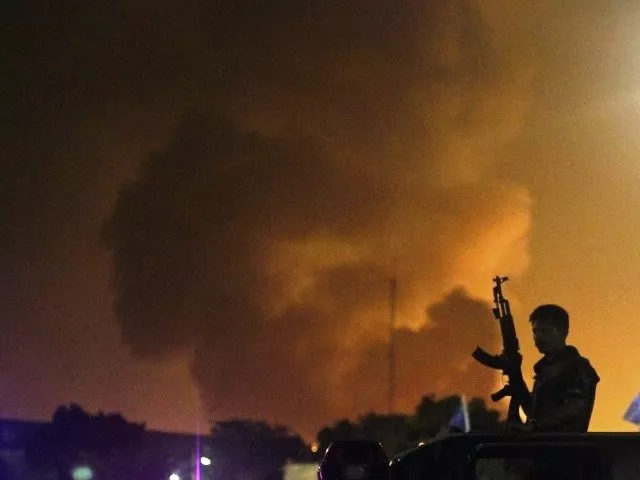
A pilot’s perspective on the security lapse at Karachi airport
Anyone from the janitor to the paan waala will tell you the Fokker gate entrance is the most vulnerable access point.
As a pilot, I’m often quizzed endlessly in great depth, particularly by those fearful of flying about how safe it really is to fly. My answer is always the same - you are the safest after take-off, having had already traversed the most dangerous part of your journey, that is from your home to the airport and onto the aircraft.
Nowhere does this statement hold truer than in the terrorist metropolis of Karachi. My sole apprehension on every flight, in and out of Karachi, pertains to getting from Defence to the airport, and vice versa.
And Sunday night, my ultimate fear manifested itself. In an attack similar to those conducted recently at PNS Mehran and Kamra Airbase at Karachis’ civilian airport, terrorists donning airline uniforms infiltrated the airport and wreaked havoc at Karachi’s one and only gateway.
Following the attack, the media played its part and created confusion as well by making invalid statements and reporting misinformation in hopes to increase viewership and ratings. Hardly any emphasis was placed on exposing real facts and come morning, inadequate accurate information had emerged.
So far all we know is that uniformed terrorists infiltrated the old terminal through the Fokker/Chairman gate, which is the entrance to the national airline’s maintenance facilities immediately opposite the airlines headquarter. Secured by a few Airport Security Force (ASF) personnel, a metal detector and an x-ray machine with barely 50 metres between the roadside and airside, this entrance possesses the least number of obstacles for an infiltrator. The entrance is an open doorway without even the protection of a physical door. Since this doorway does not lie in the path of the travelling public, it has been overlooked by the ASF as a serious security threat. Anyone from the janitor to the paan waala will tell you that this entrance is the most vulnerable access point.
I recall being surprised at the lack of security and proximity to the roadside this entrance posed the first time I traversed it. The terrorists allegedly fought past the ASF personnel and were able to move large amounts of munitions inside the premises thereafter.
The damage they inflicted therein is irrelevant to this discussion and the entire attack seems to have been accounted for by the Tehreek-e-Taliban Pakistan (TTP) as reciprocation to the army’s air strikes in North Waziristan.
Since tens of thousands of us pass through this very airport, this attack, in particular, has touched us personally and as a nation we are all wondering how it can be so easy to infiltrate and destroy such a fortified strategic asset. Similar questions were asked by the world post 9/11.
How could all that security, screening, intelligence and multi-layered protection have been bypassed so easily? And in both situations, the answer is the same – it all boils down to the mind-set of the defenders, in this case the ASF.
To understand the situation, let’s look at the current airport security and how it evolved into this supposed modern high level of impenetrability.
The ASF was established in 1976, for protection of the Civil Aviation Authority (CAA), but was moved to the auspices of the defence department in 1984. The CAA, which administers and regulates (a contradiction in itself) airports in the country, collects billions of rupees from travellers, airlines that visit and traverse the airports and airspace, advertisers and countless others. It is hailed as one of the wealthiest departments of the government. Yet, its facilities are archaic and aviation professionals regard the lack of adequate facilities as contributory to the recent aviation catastrophes in the country. Similarly, the ASF is relatively poorly equipped and struggles to accomplish its mission to secure airports nationwide, routinely coming under attack in areas such as Peshawar and Balochistan.
Simple and very visible areas of security such as airport access points are usually wide open doorways. They are sometimes ‘guarded’ by a single ASF member who visually identifies a familiar uniform and rarely checks for any identification card (which in itself can easily be reproduced by a 12-year-old with a scanner and a printer). Thousands of protocol passes are also issued by the CAA and ASF every year to facilitate the passage of VIPs and wearers of such passes do not even require a uniform to gain access. They simply display the said piece of laminated, stamped paper.
Internationally, airport access points are closed and not so easily duplicable electronic systems are required to gain access. The so-called bomb detectors, or toy remote control antennas as my three-year-old calls them, cannot distinguish between a smart phone and a weapon, and have been proven useless by numerous agencies. Yet, we continue to deploy them nationwide.
The CAA and ASF should have invested heavily in electronic access systems and border style x-ray explosive detectors through which the entire vehicle can pass and be scanned.
But these are really all just deterrents and one cannot help but recall the hijacking of a PIA F-27 aircraft where it was the ASF guard who, for a few thousand rupees, provided the hijacker with the weapon he used. If weapons can be smuggled into maximum security prisons, how can an airport with millions of travellers and tonnes of baggage passing through it be made 100% secure?
No, it is this belief in the impossible that has got us to this point. But let us examine how we got here.
In the early days of modern aviation, circa 50s to 60s, terrorism hadn’t been invented and there were no body scans or x- rays. Passengers travelled freely and the prevalent mind-set was one of making the aircraft safer. This changed drastically in the 70s and 80s, also known as the golden age of hijacking when dozens of aircraft were hijacked by everyone from frustrated ticket sales agents to religious extremists. During this period, the era of airport security evolved and, body and baggage searches, x-ray machines and metal detectors were slowly deployed across the globe.
Pakistan had its fair share of hijackings, with both PIA and international airlines the likes of Pan Am being hijacked at Karachi. The security mind-set migrated to cater to the hijacker/bomber and tactics, and deterrents devised accordingly.
Over time, it was generally assumed that an attack on an airliner would come in this form and so it was on that fateful day in September that the world was rocked when multiple aircrafts were hijacked to be flown into the Twin Towers. The only weapon the hijackers had was their minds and determination, something no deterrent system or x-ray machine could ever detect.
Even today, it is widely acknowledged that an attack such as 9/11 would go undetected. It just so happened that the 9/11 hijackers managed to smuggle cutters on-board. However, these were irrelevant to the hijackings and a weapon could have been fashioned from anything on-board, from cutlery to aircraft parts. Yet, the new mind-set emerged to detect hidden weapons and anything from toothpaste to a child’s toy gun was considered dangerous.
Yet, the real danger, the element of surprise and the changing mind-set of the enemy was not acknowledged. Billions of travellers’ dollars are spent separating the traveller from his perfume, whilst the terrorists simply adapted to these measures and formed a new method of attack, such as what we witnessed the other night.
Most ironically, pilots are also searched and are not allowed to carry a screwdriver or butter knife on-board. However, there is a two feet serrated axe at their disposal, the cutlery on-board is often metallic and the ultimate weapon, the airplane itself is entrusted to them. This then demonstrates our inability to adapt and the travelling public’s disposition to accept anything in the name of security, no matter how illogical.
In Pakistan, intelligence is supreme and has access to unlimited resources; yet we cannot pre-empt an attack identical to the two recently carried out? Even a day after the attack, chaos ensued as multiple agencies tried to decipher the security situation and struggled to give the all clear. Such multi-agency responses require better coordination and a system must be established that places control and response in capable and deployable hands.
The only real security we have is to adapt like the terrorist, which can only be done through intelligence gathering and by accepting that the enemy is capable of anything. Until we do not acknowledge the need to start searching for the wielder of the weapons, rather than the weapons themselves as we currently do, we have little chance against such extremists and their imaginations.
[poll id="343"]

COMMENTS
Comments are moderated and generally will be posted if they are on-topic and not abusive.
For more information, please see our Comments FAQ